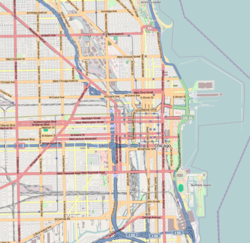This article has an unclear citation style. (December 2023) |
Hull House | |
 Hull House in the early 20th century | |
| Location | 800 S. Halsted, Chicago, Illinois, U.S. |
|---|---|
| Coordinates | 41°52′18″N 87°38′51″W / 41.87167°N 87.64750°W |
| Area | 1 acre (0.40 ha) |
| Built | building built in 1856, institution founded September 18, 1889 |
| Architect | Pond and Pond |
| Architectural style | Italianate |
| NRHP reference No. | 66000315 |
| Significant dates | |
| Added to NRHP | October 15, 1966 |
| Designated NHL | June 23, 1965[1] |
| Designated CL | June 12, 1974 |
Hull House was a settlement house in Chicago, Illinois, that was co-founded in 1889 by Jane Addams and Ellen Gates Starr. Located on the Near West Side of Chicago, Hull House, named after the original house's first owner Charles Jerald Hull, opened to serve recently arrived European immigrants. By 1911, Hull House had expanded to 13 buildings. In 1912, the Hull House complex was completed with the addition of a summer camp, the Bowen Country Club.[2][3][4] With its innovative social, educational, and artistic programs, Hull House became the standard bearer for the movement; by 1920, it grew to approximately 500 settlement houses nationally.[5]
The Hull mansion and several subsequent acquisitions were continuously renovated to accommodate the changing demands of the association. In the mid-1960s, most of the Hull House buildings were demolished for the construction of the University of Illinois Chicago. The original building and one additional building (which has been moved 200 yards (182.9 m))[6] survive today. On June 23, 1965, it was designated as a U.S. National Historic Landmark.[7] On October 15, 1966, the day that the National Historic Preservation Act of 1966 was enacted, it was listed on the National Register of Historic Places. On June 12, 1974, the surviving Hull mansion was designated as a Chicago Landmark.[8]
Hull mansion was one of the first four structures to be listed on both the Chicago Registered Historic Places and the National Register of Historic Places list (along with Chicago Pile-1, Robie House & Lorado Taft Midway Studios).[9] After The Hull House Association moved from the original buildings complex in the 1960s, it continued to provide social services in multiple locations throughout Chicago. It finally ceased operations in January 2012. The Hull mansion and a related dining hall, the only remaining survivors on the Hull House complex, are now maintained as a history museum.
- ^ "Hull House". National Historic Landmark summary listing. National Park Service. Archived from the original on November 14, 2007. Retrieved June 11, 2008.
- ^ "Home Page". Taylor Street Archives. Archived from the original on October 20, 2013. Retrieved January 5, 2021.
{{cite web}}: CS1 maint: unfit URL (link) - ^ Hull House Museum
- ^ Jane Addams, Twenty Years at Hull House
- ^ Johnson, Mary Ann (2004). "Hull House". In Grossman, James R.; Keating, Ann Durkin; Reiff, Janice L. (eds.). The Encyclopedia of Chicago. Chicago Historical Society.
- ^ Schulte, Franz and Kevin Harrington, Chicago's Famous Buildings, fifth edition, University of Chicago Press, 2004, pp. 212–3, ISBN 0-226-74066-8.
- ^ "Hull House". National Park Service. Archived from the original on November 14, 2007. Retrieved March 23, 2007.
- ^ "Jane Addams' Hull House". City of Chicago Department of Planning and Development, Landmarks Division. 2003. Archived from the original on August 3, 2001. Retrieved March 6, 2007.
- ^ "National Register Information System". National Register of Historic Places. National Park Service. January 23, 2007.
